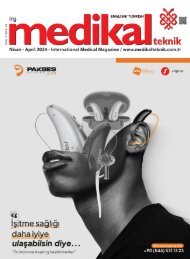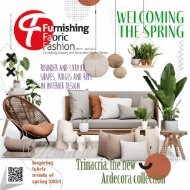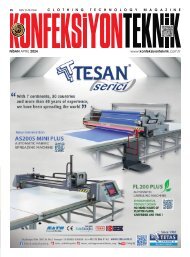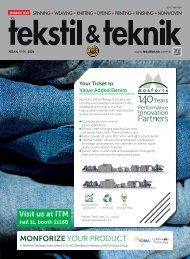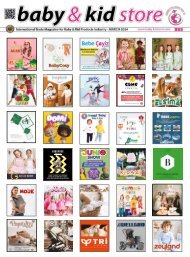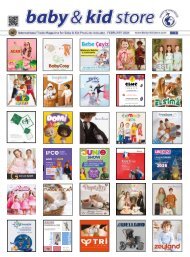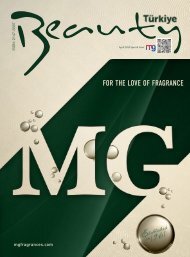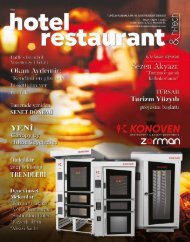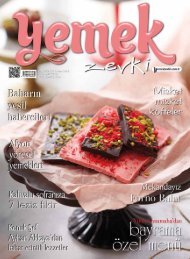Tekstil Teknik October 2020
Tekstil Teknik October 2020
Tekstil Teknik October 2020
- No tags were found...
You also want an ePaper? Increase the reach of your titles
YUMPU automatically turns print PDFs into web optimized ePapers that Google loves.
72 MAKALE
the stretching motion of intra-molecular hydrogen
bonds which is related to cellulose I. The intensity
observed at the peak of 1627 cm -1 is related to the
adsorbed moisture (H2O). Important features of
the spectra are shown in table 7 [21, 22, 23, 24].
Figure 2 shows that 100% Lyocell knitted fabric as
confirmed by ATR-FTIR spectra is around the wave
number of 1100 cm -1 . Other frequency bands and
peaks of great intensity for lyocell are also listed in
table 7 [25, 26]. Figure2 Figure3
Infrared spectra of all fabrics indicate that there
were distinguishable peaks. Deterministic peaks of
designed fabrics are listed in table 7 below. Table 7
Statistical analysis of results was performed in
SPSS by applying analysis of variance (Table 8). In
addition, in order to check the effects of parameters
on each other, Pearson correlation tests were
performed (Table 9). Table 8
Effect of fabric type on antibacterial activity, whiteness
and hydrophilicity was significant, but it was
unremarkable on water retention power. Table 9
A correlation between hydrophilicity and antibacterial
activity is seen in statistical analysis. Accordingly,
effect of hydrophilic characteristic was
significant on antibacterial activity (oc =0.05).
Water retention power was not efficient on antibacterial
activity since all fabrics were immersed into
water, kept in funnels and squeezed with water
for water retention power test. Water was almost
forced into fabric owing to test pattern, and this
test had longer processing time compared to
hydrophilicity test standard. Therefore, while results
of hydrophilicity were different, results of water
retention power were almost similar in the study.
4. Conclusions
Different from many previous researches, antibacterial
characteristics of PLA fibers and its blends
with Lyocell and Cotton fibers were investigated
in this study without use of any additives such as
silver, chitosan, etc. Besides, It is seen that PLA
reinforced composites are subjected to many
articles on academic and commercial areas
[27]. But there are limited investigations on characterization
of PLA mixtures knitted fabrics. This
article present some properties of hybrid knitted
fabrics. ATR-FTIR was used for analyzing chemical
structure of fibers in order to clarify some of the
characteristics of designed fabrics which were
investigated in this study. Chemical bonds and
molecular regions of fibers were checked and linked
with other properties through ATR FTIR analysis.
Finally, it was seen that while there was more
antibacterial efficiency since bacteria couldn’t
destroy strong carbonyl stretching bonds in PLA,
they could grow easily in Cotton and Lyocell
fabrics owing to weak hydrogen bonds. Similar
effect of chemical structure in terms of hydrophilicity
and water retention power should be taken
into consideration. It was found out that knitted
fabrics composed of PLA and its mixtures with
Lyocell and Cotton fibers had insufficient level of
antibacterial activity. Hydrophilic characteristics
of PLA/Lyocell fabric was confirmed to show high
value. In addition, water retention power of the
fabric was sufficient to take into account other
raw materials. Furthermore, when their whiteness
values were checked, it was seen that they had
enough level of whiteness. These results support
optimization of textile finishing processes of PLA
mixtures fabrics for future studies. As well as
many advantages of PLA fiber in term of environmentally
friendly new generation fiber, it is a
hydrophobic fibre and has many disadvantages
especially at pre-treatment processes in textile finishing.
The results of this study shows Lyocell and
Cotton mixtures how much increase or decrease
of pure PLA fiber specifications.
TEKSTİL & TEKNİK | EKİM | OCTOBER | 2020
References: 1.Shanmugasundaram O. Lakshmanan and Guruprasad Raghavendran, Regenerated Sustainable Fibres, Sustainable
Innovationsin Textile Fibres, Textile Science and Clothing Technology,Hong Kong,31,(2018) 2. White P., Hayhurst M., Taylor J. & Slater A.,
Biodeg. and Sust. Fibres, Edited by Richard Blackburn, University of Leeds, Woodhead Publising Limited,Cambrigde England, Chapter 5,
157, (2005) 3. Farington D.W., Lunt J., Davies S. & Blackburn R. S., Biodeg. and Sust. Fibres, Edited by Richard Blackburn, University of Leeds,
Woodhead Publising Limited,Cambrigde England, Chapter 6,191, (2005) 4. Dattilo P.P.Jr., King M.W., Cassil N.L. & Leung J.C.,J. of Text. and
Apparel, Tech. and Manag., 2(2),1, (2002) 5.Gao Y. & Cranston R, Text. Res. J., 78(1), 60, (2008) 6.Supuren G., Kanat Z.E., Cay A. &Tarakcıoglu
I.,Teks. ve Konf.,16(2), 80, (2006) 7. AATCC Test Method 100-2004’’ , Antibacterial finishes on textile materials: Assessment of. AATCC
Technical Manual’’, American Ass. of Text. Chem. and Colorists, Research Triangle Park, NC, (2005) 8. DIN 53924, Testing of textiles-Velocity
of soaking water of textile fabrics (method by determining the rising height), Standard by Deutsches Institut Fur Normung E.V.(German
National Standard),( 1997) 9. DIN 53814, Testing of textiles; determination of water retention power of fibres and yarn cuttings, Standard
by Deutsches Institut Fur Normung E.V.(German National Standard), (1974) 10. Can C.,’’Zeolit Mineralinin Tekstil Terbiyesinde Kullanım
Olanaklarının Araştırılması’’ Ege Universitesi, Fen Bilimleri Enstitüsü, Doktora Tezi, 53, (2012) 11. Kreze T., Stana-Kleinschek K. & Ribitsch V., Lenzinger
Berichte, 80, 28, (2001) 12.Strnad S., Sauperl O. & Fras-Zemljic L., Biopolym., Edited by Magdy Elnashar, 181, (2010) 13.Garlotta D., J.
of Polym. and the Environment, 9( 2), 63,(2002) 14. Mak C. M., Yuen C. W. M., Ku S. K. A. &Kan C. W.,The J. of The Text. Inst., 97(6), 533, (2006)
15. Alay, E., Improved of Biodegradable, Antibacterial, Odor Resistant Knitted Fabrics, Doctor of Philosophy, Ege University, Graduate
School of Natural and Applied Sciences, Textile Technologies, (2016) 16. Bajpai V., Bajpai S., Jha1 M.K., Dey A., & Ghosh S., J.Environ, Res.
Edu., 5( 3), 669, (2011) 17. Boryo D.E.A., The Int. J. of Eng. And Sci. (IJES), 2 (8),9, (2013) 18. X.W. Yuan, D. Liu, A.J. Easteal, D. Bhattacharyya &
J. Li, Proceedings, iccmcentral, Biomedical Aplications,,(2010) 19. Baig G.A, Indian J. of Fibre &Text. Res.,38, 22, (2013) 20. Hossain K.M.Z,
Parsons A.J., Rudd C.D., Ahmed I., &Thieleman W., European Polym. J., 53 ,270, (2014) 21. Pamula E.,Blazewicz M.,Paluszkiewicz C., &Dobrzynski
P.,J. of Moleculer Struc., 596 ,69, (2001) 22. Garside P. & Wyeth P., Studies in Conservation, 48(4), 269, (2003) 23.Dave H., Ledwani L.,
Chandwani N., Chauhan N., & Nema S.K., The J. of The Text. Inst., 105( 6), 586, (2014) 24. Liu Y., Materials, 6, 299, (2013) 25. Kaimouz A.W.,
An Investigation of the Printing Process for Lyocell and Cotton Fibers Using Inkjet Technology, Doctor of Philosophy,Heriot-Watt University,The
School of Textile and Design, 177, (2010) 26.Ozturk H.B., Ehrhardt A., Vu-Manh H., Oksanen T., Siroká B., Suurnakki A., & Bechtold T.,
Fibres & Text. in Eastern Europe, 19( 4) , 87, (2011) 27.Behnaz Baghaei, Mikael Skrifvars, Characterisation of polylactic acid biocomposites
made from prepregs composed of woven polylactic acid/hemp–Lyocell hybrid yarn fabrics, Composites: Part A, 81, 139, (2016)



